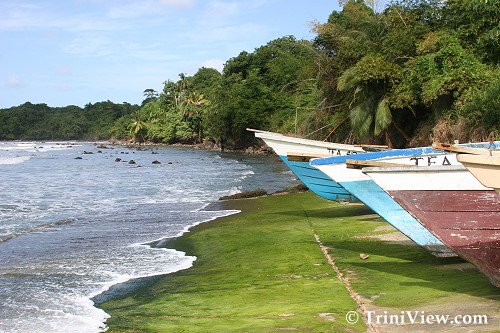 Fishing boats along the shore in front of the Toco Fishing Centre
Fishing boats along the shore in front of the Toco Fishing Centre
TriniView.com Staff Article
Event Date: December 26, 2006
Posted: December 30, 2006
It is a most common assumption that once you have left Valencia and have entered into the region of the northeast coast, that you have arrived in Toco village. This is a myth, for although the Toco main road passes through several villages such as Balandra, Rampanalgas and Cumana and the entire region is referred to as the Toco region, the Toco village lies at the center of a chain of 14 coastal villages.
The village of Toco is the most northeasterly village on the island of Trinidad at the point where the Caribbean Sea and the Atlantic Ocean meet. Tobago lies only some 35 kilometers to the northeast which renders Toco the closest point in Trinidad to the sister island. The name Toco was ascribed to the area by its early Amerindian inhabitants. The meaning of the name is uncertain, yet its historical significance and value to the country is well noted.
One of the most notable areas in the Toco region is Punta Galera (now Galera Point). Galera is a slight corruption of the word "galea", the name originally given to the southeastern point, Galeota Point, by Christopher Columbus. The name was accidentally given to this point as well. However, the name stuck and it remains a popular tourist destination. The Galera Point Lighthouse in Toco was built in 1897 and today is surrounded by a park and picnic area which has added to its attractiveness.
Not much activity took place in Toco after the Spanish colonized Trinidad until 1631, when Sir Henry Colt and the British forces entered the territory without the knowledge of the Spanish. In 1637, the British were expelled by the Dutch, who had formed an alliance with the Amerindians in the area and were, not too long after, expelled by the Spanish.
After that escapade, nothing major that was historically recorded occurred until about one hundred years later when Capuchin priests from Spain came to convert the Amerindians to Roman Catholicism. The mission village in Toco, which was set up to carry through with their proselytizing objectives, was named Mission Village and existed even after the British takeover of Trinidad in 1797. There was another mission that existed in the area in the region of Cumana and was adjoined to the mission in Toco by way of the Anglais Road.
The French also had a big part to play in the history of Toco. They had flocked to the region a few years after 1783, when the Cedula of Population came into effect encouraging French islanders immigration into Trinidad. In an attempt to seal off the northeast and the eastern areas, the 6 parcels of land (the Toco area) were sold. Some of these settlers included the D'Godet's, the Monique's, the Ponne's, the Traille's, the Narcise's and the Rotan's.
Unlike many other areas in Trinidad and Tobago, the land in Toco was not suitable for extensive sugarcane cultivation. Thus, by 1797, there was only one sugar mill in the entire district. However, the land was quite suitable for cotton production. In 1797, there were as many as 59 cotton mills and the population during that period consisted of 159 enslaved Africans, 62 "free" blacks, 28 French settlers and 155 Amerindians who supposedly lived on the missions. Amerindians (Caribs) also lived in other areas of Toco and Cumana during that period.
There were no roads connecting Toco with the rest of the island, and so, when in 1818, the round island steamer service was started by Governor Ralph Woodford, Toco benefited from this new transportation system to accommodate the trade in cocoa and other goods.
Also during that century, in 1830, the Catholic Church made Toco a parish and dedicated the newly built Our Lady of the Assumption Church at Mission Village to it. The Capuchins had established the first church in the area.
In 1849, Lord Harris was responsible for creating ward boundaries. Toco was also one of the earliest villages to receive schools under the ward system as early as 1862. Despite the supposed functionality of the ward system, residents of the area had refused to pay ward rates for developmental purposes and so by 1852, approximately 64 Toco estates were put up for sale. This and other factors could have contributed to the sparse population of the area.
However, by 1881, the population of Toco grew due to the popularity of the cocoa and coffee industry and the influx of workers from Tobago. In fact, at one point in time, Toco was mainly populated by people from the island of Tobago.
By 1930, the first road into Toco linking it with Sangre Grande was built ending the dependence on the round island ferry service and the influx of people from Tobago into the area.
Today, Toco remains sparsely populated although the numbers have grown since the olden days. In fact, in 1980, census reports indicate that the population was about 1311.
With its serene atmosphere and picturesque beaches, Toco remains one of the most popular vacationing spots in Trinidad and Tobago.
Balandra, Cumana and Toco in pictures:
www.triniview.com/gallery/main.php?g2_itemId=151745
Toco | Homepage | Special Events | Photo Gallery
|
